A Novel Hydraulic Mode to Promote Gas Extraction: Pressure Relief Technologies for Tectonic Regions and Fracturing Technologies for Nontectonic Regions
Abstract
:1. Introduction
2. Introduction of the Novel Hydraulic Technology Mode
2.1. Background of the Novel Hydraulic Technology Mode
2.2. Technological Processes of the Novel Hydraulic Technology Mode
2.2.1. Components of the Novel Hydraulic Technology Mode
2.2.2. Implementation Steps
2.3. Characteristics of the Novel Hydraulic Technology Mode
3. Test Site and Field Testing
3.1. Introduction to the Coal Mine
3.2. Working Design
4. Results and Discussion
4.1. Gas extraction Effectiveness
4.2. Gas Content after Extraction
4.3. Gas Concentration in the Return Airway
4.4. Time Required to Meet Government Standards
5. Conclusions
- A novel mode for applying hydraulic technology to complex coal seams is proposed in this paper to promote gas extraction. This mode divides complex coal seams into tectonic regions and nontectonic regions based on geological structures. The advantages of different hydraulic technologies are matched with the characteristics of the different areas, such as HOST for tectonic regions and SDHFT for nontectonic regions. The permeability of coal seams can be sharply increased by pressure relief or fracturing methods, without leaving unfractured areas, and can promote gas extraction and ensure that coal mine production continues safely and efficiently. Additionally, this mode has the following characteristics: good applicability, more advantages, better effectiveness, and economic rationality. This mode will also be more mature with the development of the geological exploration techniques.
- Application of this mode on adjacent working faces in the Datong First Coal Mine shows that this mode has better effectiveness than SDHFT. The gas concentration and flow of pure gas used in this novel mode were increased by 47.1% (from 16.96% to 24.94%) and 44.6% (from 4.24 m3/min to 6.13 m3/min) compared with SDHFT over 9 months. The extraction effectiveness was better, and the extraction time was reduced by 4 months. The pre-extraction rate for this novel mode was 66.8% over 9 months, and the pre-extraction rate for SDHFT was 63.3% over 13 months. This mode will reduce (or even eliminate) the number of times that gas concentration exceeds government standards during coal roadway excavation (from 16 to 2). In addition, this mode increased the coal roadway excavation speed by 16% (up to 158 m/month).
Author Contributions
Funding
Acknowledgments
Conflicts of Interest
References
- Ritter, D.; Vinson, D.; Barnhart, E.; Akob, D.M.; Fields, M.W.; Cunningham, A.; Orem, W.; McIntosh, J.C. Enhanced microbial coalbed methane generation: A review of research, commercial activity, and remaining challenges. Int. J. Coal Geol. 2015, 146, 28–41. [Google Scholar] [CrossRef]
- Karacan, C.O.; Ruiz, F.A.; Cote, M.; Phipps, S. Coal mine methane: A review of capture and utilization practices with benefits to mining safety and to greenhouse gas reduction. Int. J. Coal Geol. 2011, 86, 121–156. [Google Scholar] [CrossRef]
- Moore, T.A. Coalbed methane: A review. Int. J. Coal Geol. 2012, 101, 36–81. [Google Scholar] [CrossRef]
- Towler, B.; Firouzi, M.; Underschultz, J.; Rifkin, W.; Garnett, A.; Schultz, H.; Esterle, J.; Tyson, S.; Witt, K. An overview of the coal seam gas developments in Queensland. J. Nat. Gas Sci. Eng. 2016, 31, 249–271. [Google Scholar] [CrossRef]
- Vedachalam, N.; Srinivasalu, S.; Rajendran, G.; Ramadass, G.A.; Atmanand, M.A. Review of unconventional hydrocarbon resources in major energy consuming countries and efforts in realizing natural gas hydrates as a future source of energy. J. Nat. Gas Sci. Eng. 2015, 26, 163–175. [Google Scholar] [CrossRef]
- Li, H.Y.; Lau, H.C.; Huang, S. China’s coalbed methane development: A review of the challenges and opportunities in subsurface and surface engineering. J. Pet. Sci. Eng. 2018, 166, 621–635. [Google Scholar] [CrossRef]
- Zhou, H.X.; Yang, Q.L.; Cheng, Y.P.; Ge, C.G.; Chen, J.X. Methane drainage and utilization in coal mines with strong coal and gas outburst dangers: A case study in Luling mine, China. J. Nat. Gas Sci. Eng. 2014, 20, 357–365. [Google Scholar] [CrossRef]
- Aguado, M.B.D.; Nicieza, C.G. Control and prevention of gas outbursts in coal mines, Riosa-Olloniego coalfield, Spain. Int. J. Coal Geol. 2007, 69, 253–266. [Google Scholar] [CrossRef]
- Karacan, C.O.; Daimond, W.P.; Schaltzel, S.J. Numerical analysis of the influence inseam horizontal methane drainage boreholes in longwall face emission rate. Int. J. Coal Geol. 2007, 72, 13–32. [Google Scholar] [CrossRef]
- Lu, Y.Y.; Liu, Y.; Li, X.H.; Kang, Y. A new method of drilling long boreholes in low permeability coal by improving its permeability. Int. J. Coal Geol. 2010, 84, 94–102. [Google Scholar] [CrossRef]
- Frank, H.; Ren, T.; Naj, A. Evolution and application of in-seam drilling for gas drainage. Int. J. Min. Sci. Technol. 2013, 23, 543–553. [Google Scholar] [CrossRef]
- Cheng, L.; Ge, Z.L.; Xia, B.W.; Li, Q.; Tang, J.R.; Cheng, Y.G.; Zuo, S.J. Research on hydraulic technology for seam permeability enhancement in underground coal mines in China. Energies 2018, 11, 427. [Google Scholar] [CrossRef]
- Zhang, H.; Cheng, Y.P.; Liu, Q.Q.; Yuan, L.; Dong, J.; Wang, L.; Qi, Y.X.; Wang, W. A novel in-seam borehole hydraulic flushing gas extraction technology in the heading face: Enhanced permeability mechanism, gas flow characteristics, and application. J. Nat. Gas Sci. Eng. 2017, 46, 498–514. [Google Scholar] [CrossRef]
- Ferrer, I.; Thurman, E.M. Chemical constituents and analytical approaches for hydraulic fracturing waters. Trends Environ. Anal. Chem. 2015, 5, 18–25. [Google Scholar] [CrossRef]
- Cheng, Y.G.; Lu, Y.Y.; Ge, Z.L.; Cheng, L.; Zheng, J.W.; Zhang, W.F. Experimental study on crack propagation control and mechanism analysis of directional hydraulic fracturing. Fuel 2018, 218, 316–324. [Google Scholar] [CrossRef]
- Shimizu, H.; Murata, S.; Ishida, T. The distinct element analysis for hydraulic fracturing in hard rock considering fluid viscosity and particle size distribution. Int. J. Rock Mech. Min. Sci. 2011, 48, 712–727. [Google Scholar] [CrossRef]
- Lu, Y.Y.; Zuo, S.J.; Ge, Z.L.; Xiao, S.Q.; Cheng, Y.G. Experimental study of crack initiation and extension induced by hydraulic fracturing in a tree-type borehole array. Energies 2016, 9, 514. [Google Scholar] [CrossRef]
- Vijay, M.M.; Remisz, J.; Shen, X. Potential of pulsed water jets for cutting and fracturing of hard rock formations. Int. J. Surf. Min. Reclam. Environ. 1993, 7, 121–132. [Google Scholar] [CrossRef]
- Lu, Y.Y.; Yang, F.; Ge, Z.L.; Wang, S.Q.; Wang, Q. The influence of viscoelastic surfactant fracturing fluids on gas desorption in soft seams. J. Nat. Gas Sci. Eng. 2015, 27, 1649–1656. [Google Scholar] [CrossRef]
- Brandt, J.; Sdunowski, R. Gas Drainage in High Efficiency Workings in German Coal Mines. In Proceedings of the 2007 China (Huainan) International Symposium on Coal Gas Control Technology, Huainan, China, 25–26 October 2007; China University of Mining and Technology: Xuzhou, China, 2007; pp. 22–29. [Google Scholar]
- Wang, H.F.; Cheng, Y.P.; Yuan, L. Gas outburst disasters and the mining technology of key protective seam in coal seam group in the Huainan coalfield. Nat. Hazards 2013, 67, 763–782. [Google Scholar] [CrossRef]
- Tang, J.; Jiang, C.L.; Chen, Y.J.; Li, X.W.; Wang, G.D.; Yang, D.D. Line prediction technology for forecasting coal and gas outbursts during coal roadway tunneling. J. Nat. Gas Sci. Eng. 2016, 34, 412–418. [Google Scholar] [CrossRef]
- Shepherd, J.; Rixon, L.K.; Griffiths, L. Outbursts and geological structures in coal-mines—A review. Int. J. Rock Mech. Min. Sci. 1981, 18, 267–283. [Google Scholar] [CrossRef]
- Cao, Y.; He, D.; Glick, D.C. Coal and gas outbursts in footwalls of reverse faults. Int. J. Coal Geol. 2001, 48, 47–63. [Google Scholar] [CrossRef]
- Creedy, D.P. Geological controls on the formation and distribution of gas in British-coal measure strata. Int. J. Coal Geol. 1988, 10, 1–31. [Google Scholar] [CrossRef]
- Groshong, R.H.; Pashin, J.C.; McIntyre, M.R. Structural controls on fractured coal reservoirs in the southern Appalachian Black Warrior foreland basin. J. Struct. Geol. 2009, 31, 874–886. [Google Scholar] [CrossRef]
- Farmer, I.W.; Pooley, F.D. A hypothesis to explain the occurrence of outbursts in coal, based on a study of West Wales outburst coal. Int. J. Rock Mech. Min. Sci. 1967, 4, 189–193. [Google Scholar] [CrossRef]
- Chen, J. Gas geology law in Datong No.1 mine, Shanxi. Coal 2017, 5, 47–49. (In Chinese) [Google Scholar]
- Xu, Y.P.; Zhai, C.; Hao, L.S.; Sun, X.; Liu, Y.; Li, X.Z.; Li, Q.G. The pressure relief and permeability increase mechanism of crossing-layers directional hydraulic fracturing and its application. Procedia Eng. 2011, 26, 1184–1193. [Google Scholar] [CrossRef]
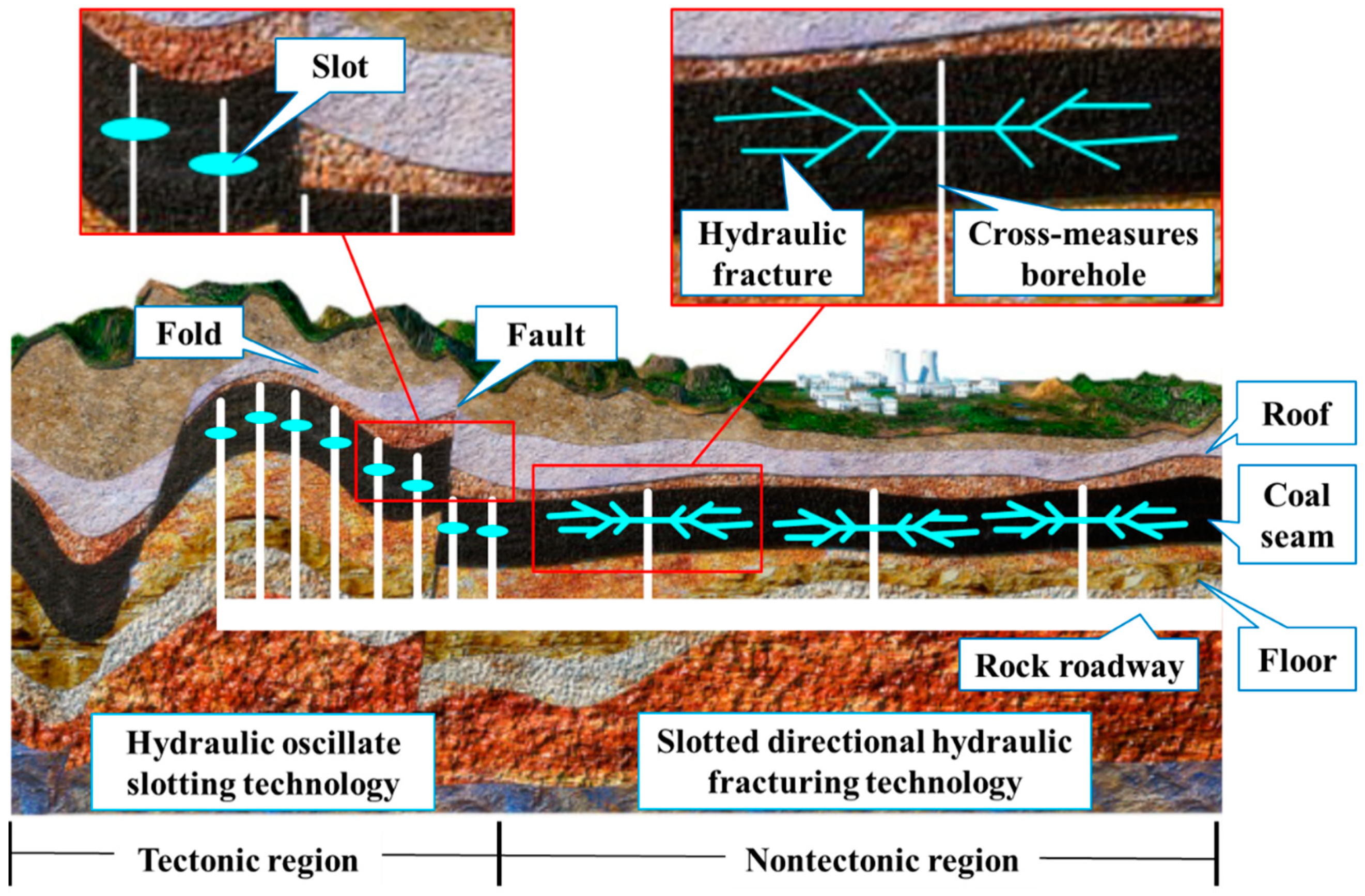
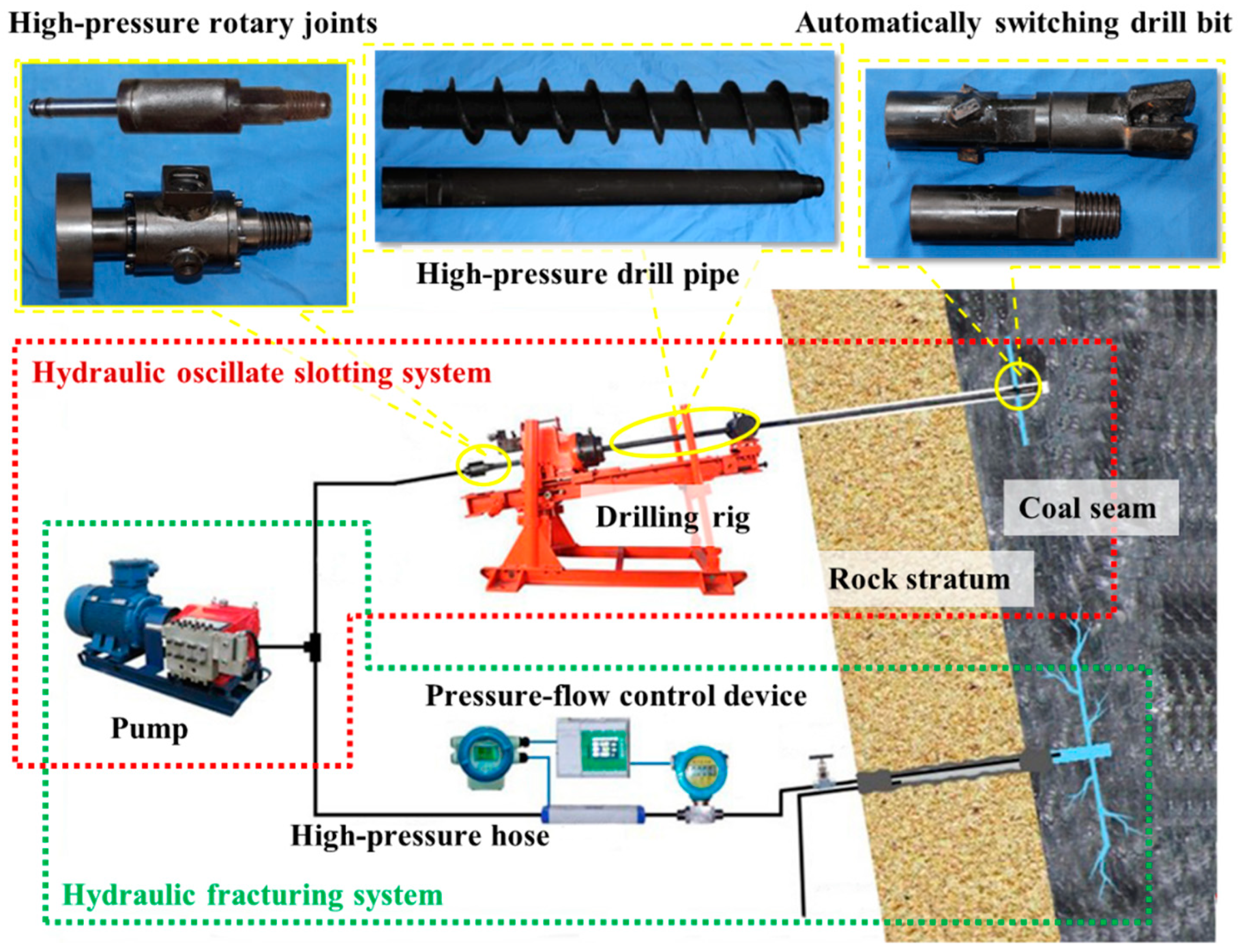
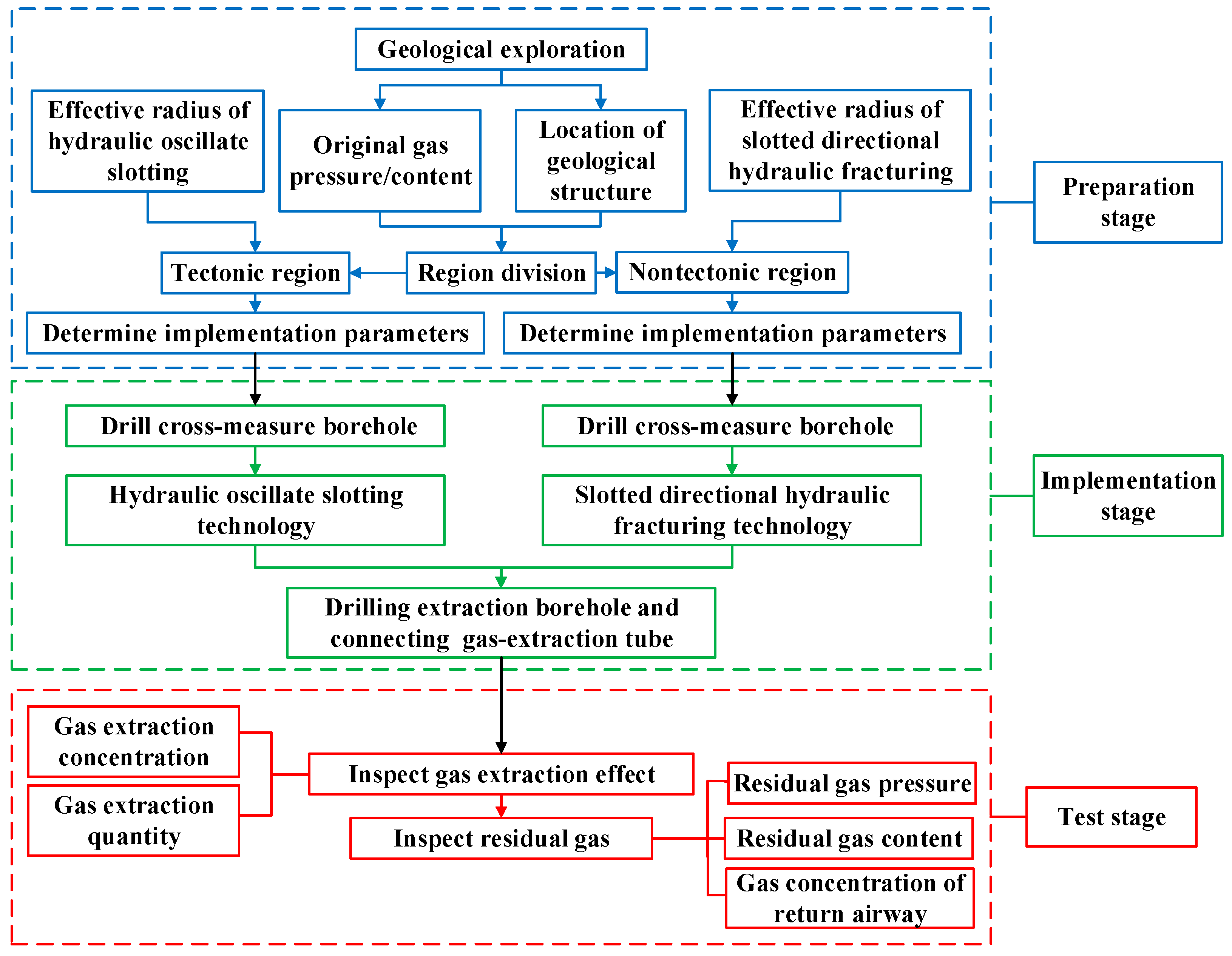
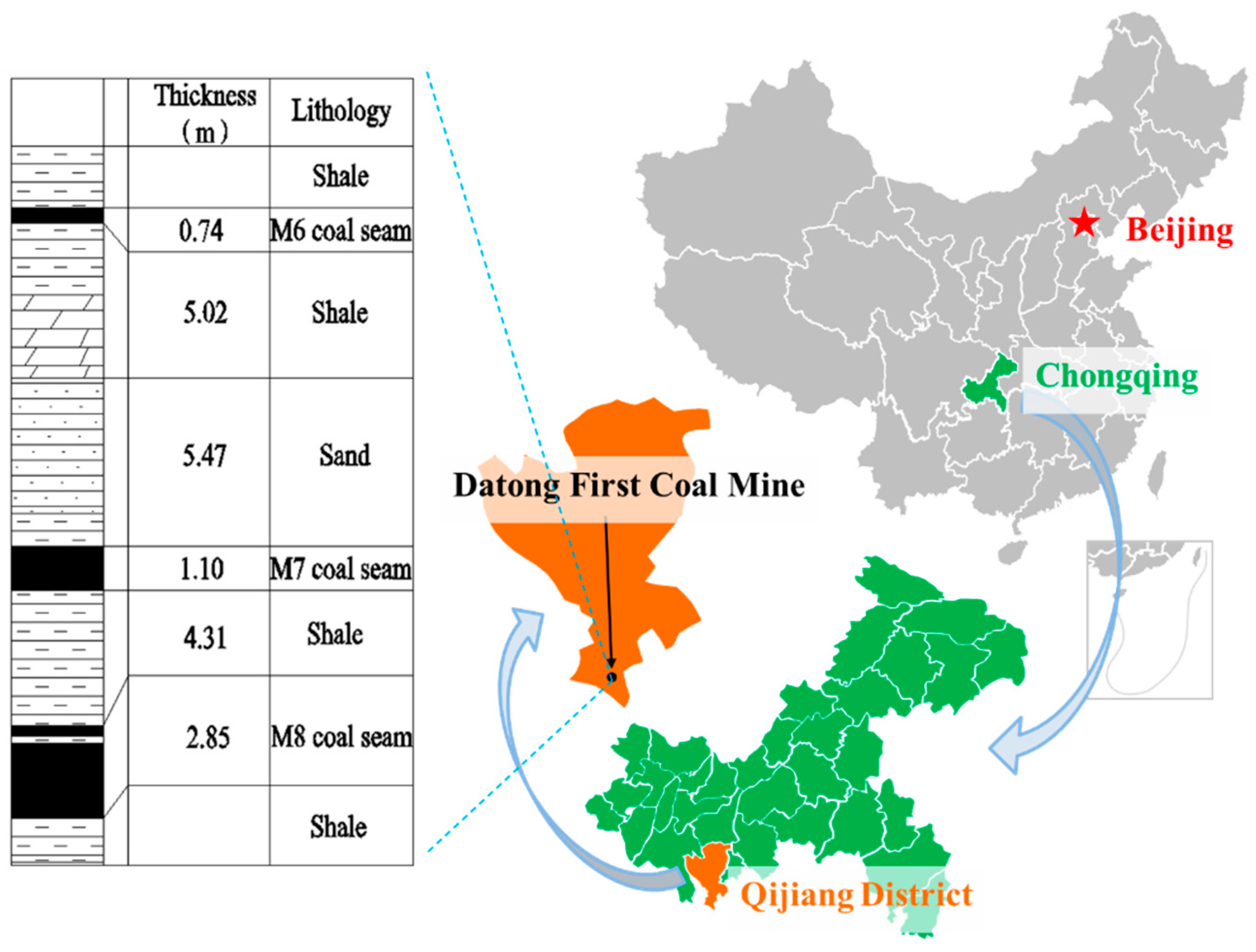
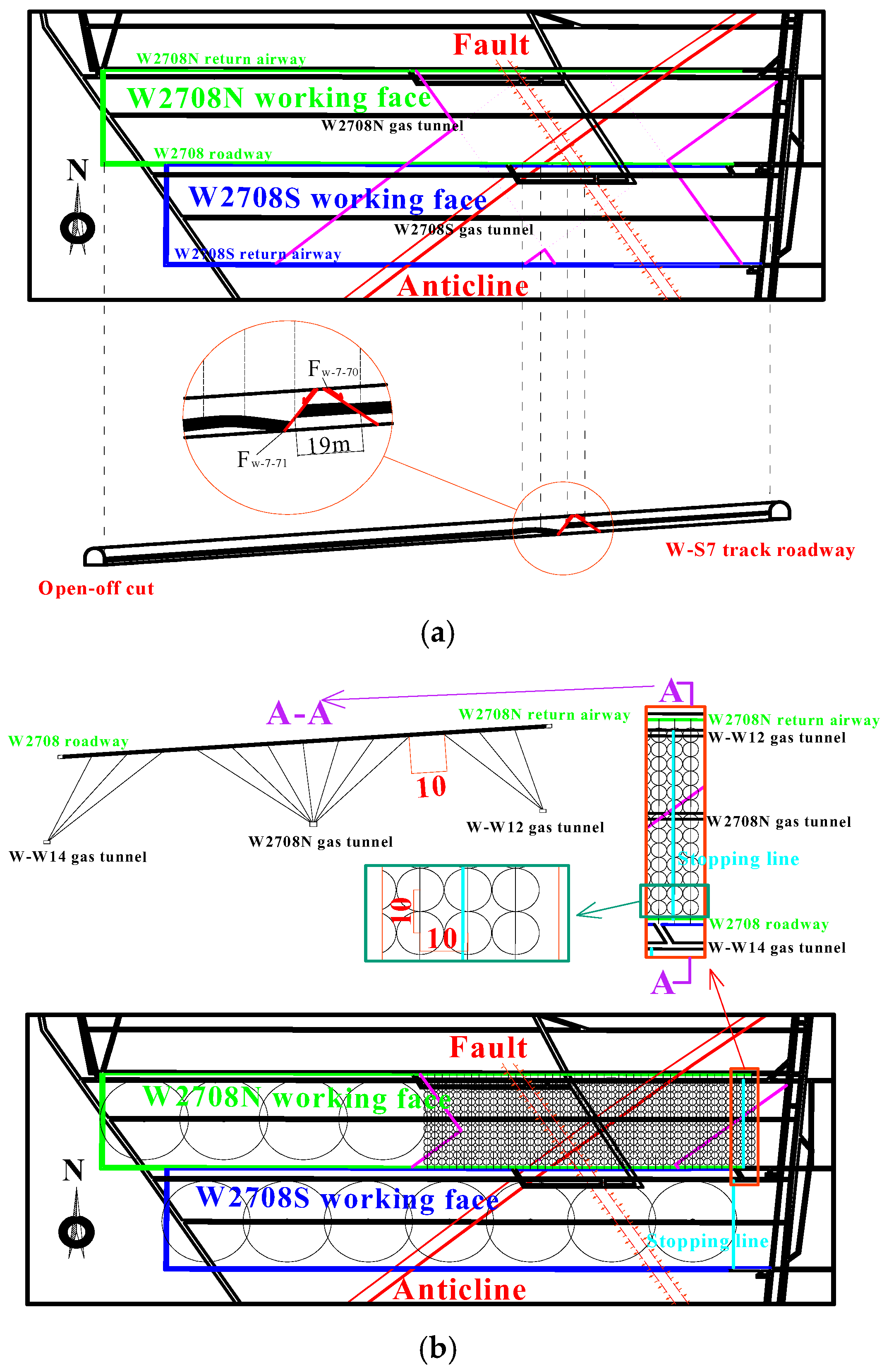
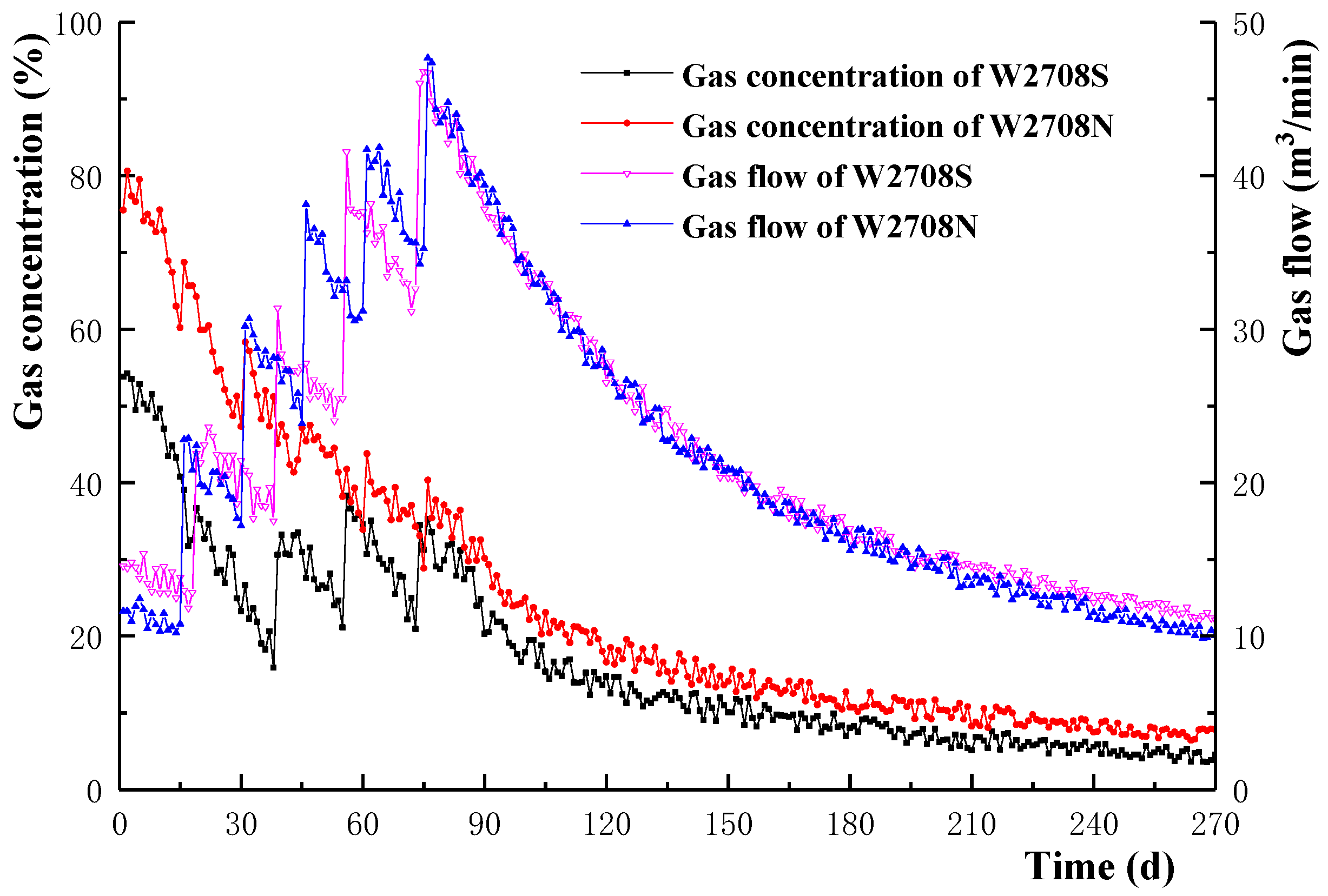

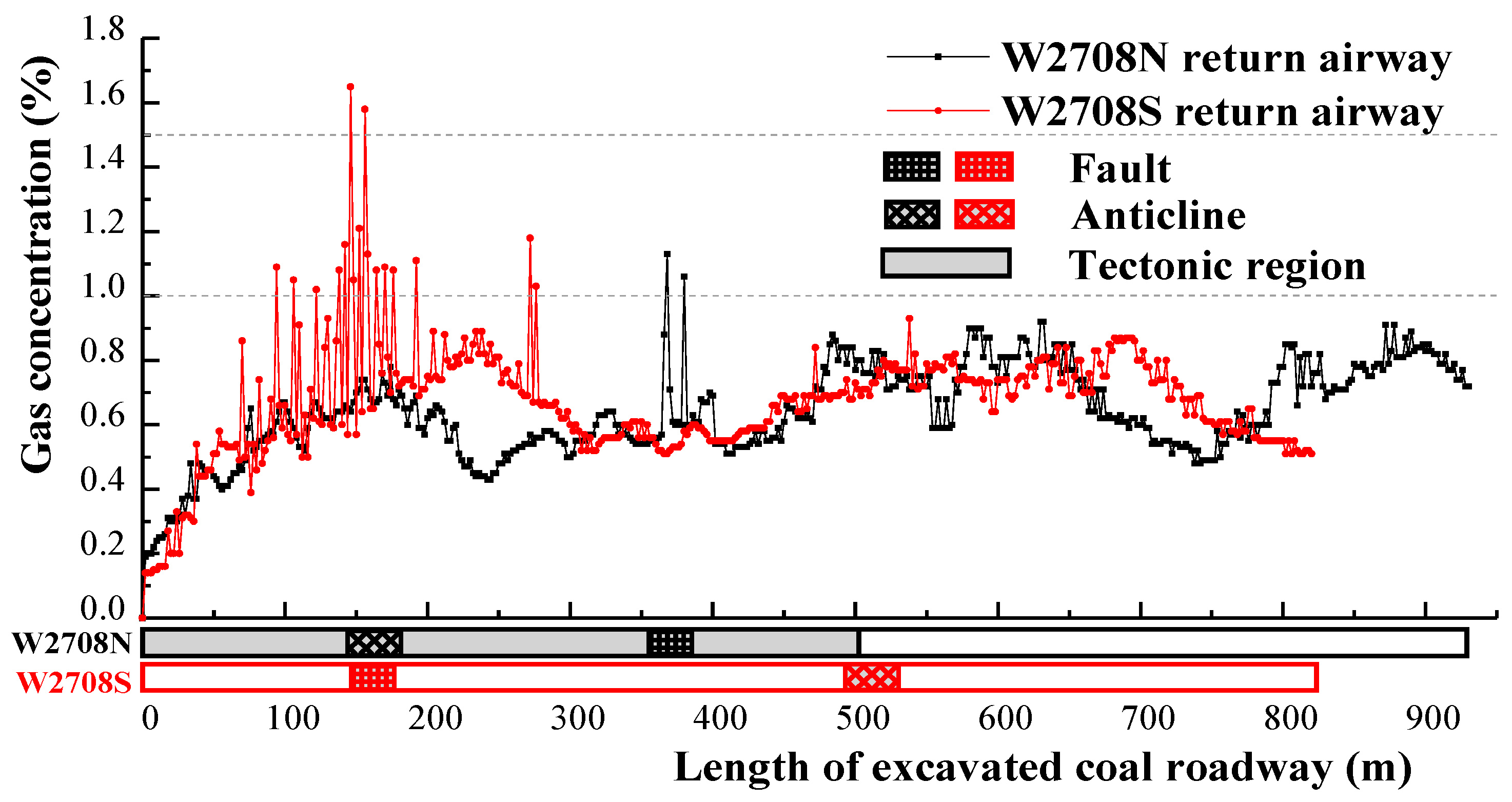
| Working Face | Time for Permeability Enhancement (months) | Time for Drilling Extraction Boreholes (months) | Time for Extraction (months) | Total Time (months) |
|---|---|---|---|---|
| W2708S | 1 | 3 | 10 | 14 |
| W2708N | 1 | 3 | 6 | 10 |
© 2019 by the authors. Licensee MDPI, Basel, Switzerland. This article is an open access article distributed under the terms and conditions of the Creative Commons Attribution (CC BY) license (http://creativecommons.org/licenses/by/4.0/).
Share and Cite
Zuo, S.; Ge, Z.; Zhou, Z.; Wang, L.; Zhao, H. A Novel Hydraulic Mode to Promote Gas Extraction: Pressure Relief Technologies for Tectonic Regions and Fracturing Technologies for Nontectonic Regions. Appl. Sci. 2019, 9, 1404. https://doi.org/10.3390/app9071404
Zuo S, Ge Z, Zhou Z, Wang L, Zhao H. A Novel Hydraulic Mode to Promote Gas Extraction: Pressure Relief Technologies for Tectonic Regions and Fracturing Technologies for Nontectonic Regions. Applied Sciences. 2019; 9(7):1404. https://doi.org/10.3390/app9071404
Chicago/Turabian StyleZuo, Shaojie, Zhaolong Ge, Zhe Zhou, Li Wang, and Hanyun Zhao. 2019. "A Novel Hydraulic Mode to Promote Gas Extraction: Pressure Relief Technologies for Tectonic Regions and Fracturing Technologies for Nontectonic Regions" Applied Sciences 9, no. 7: 1404. https://doi.org/10.3390/app9071404





